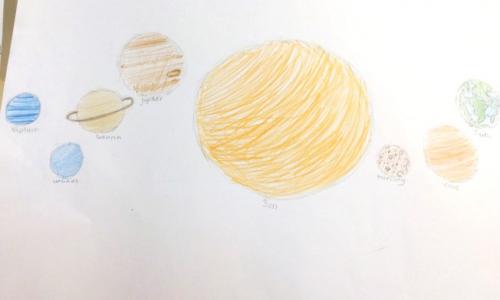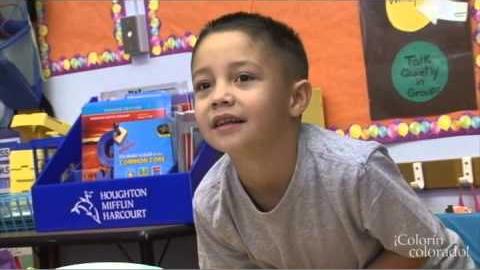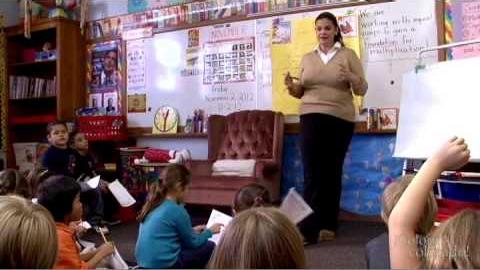Picture Retell

In this activity, students retell a narrative story or key points of an informative text using pictures from the text as a support. This strategy is part of Colorin Colorado's ELL Strategy Library and can be used to support academic language development for all students.
Strategy Overview
How This Strategy Supports Language Development
Orally retelling stories and information from texts is a foundational skill for all students. It helps multilingual learners develop reading comprehension and other skills like sequencing, vocabulary, and identifying the main idea and key details. Pictures support the retell by providing visual cues for vocabulary, sequencing, and key details. Orally retelling also supports writing.
The pictures can be created with teacher sketches, copies of pictures from the text, or student sketches. This activity can be used at any grade level and across content area.
Step-by-Step Instructions
- Choose the text for retelling and writing.
- Determine 3-8 key points for the retell, depending on the students' age, language development level, and the genre (narrative or informative).
- Determine which type of visual to use to support students (teacher sketches, copies of pictures from the text, or student drawings).
- Read the text. This can be done aloud, in partners, chorally, or independently, etc.
- Stop reading at each key detail or event to ask questions and point out a visual representation of that detail or event. Students can draw a sketch or look at a copy of the picture from the text or a teacher sketch.
- After reading the story or informational text, have students review the visuals for the story. If they have the visuals on individual note cards or papers, they can work with a partner to put the events from the story or informational text in sequence.
- Provide a word bank or label the drawings. Provide appropriate transitional phrases.
- Have students work with a partner to retell the story or information using the key vocabulary and transitional phrases.
- Have students write what they retold using the visuals and linguistic support.
Lessons Learned
- Introduce the strategy with a basic 3-4 part story or informational text.
- Add labels of key vocabulary to each visual.
- Provide transition phrases for students to use as they talk about each of the visuals.
- Ask the student with the higher proficiency level to retell first in their teams to provide a model for the other partner.
- After practicing with a partner, ask a couple of students to retell for the whole class using projected pictures.
- As a final step in this activity, ask students to write their retell. They may use their labeled pictures and word banks with transition phrases as support.
- Teach older students how to stop reading at each paragraph or chunk of text and make their own labeled drawings of the key event or concept in that chunk of text.
Differentiation
Entering/Emerging
- Purposefully partner students with a heritage language speaker who has more developed English proficiency.
- Allow students to retell in their heritage language or a mix of English and heritage language.
- In addition to labeled visuals and a word bank with transitional phrases, provide sentence frames for the retell.
Developing
- Encourage students to retell using complete sentences and transitional phrases between each picture.
- Provide a sentence frame to encourage students to use more complex sentences.
Expanding
- Ask a student at this level to share first in their partnership.
- Partner this student with a heritage English speaker.
- Encourage this student to add more details to each picture.
Co-Teaching Considerations
Content or Grade-Level Teacher
- Choose the text for the retell.
- Determine key details or plot points for a visual representation in the retell.
- Make copies of visuals from the book or teacher drawn pictures for each pair of students OR plan for time for students to draw the key points during the read aloud or while they read.
English Language Development Teacher
- Purposefully partner students.
- Create a word bank with transition phrases appropriate for the genre and grade level.
- Monitor students during the retell.
- Work with a small group of entering/emerging level students to support their picture retell.
Examples
| Topic | Examples |
|---|---|
| Retell the life cycle of a butterfly with student created pictures for each stage |  |
| Retell the sequence of a story using student- generated story map |  |
Retell information about planets using student-generated planet chart |
|
Resources
References
- Interactive Story Retelling with Pictures
- Pictorial Input Chart (GLAD)
- Dunst, C, Simkus, A, Hamby, D. (2012). Children's Story Retelling as a Literacy and Language Enhancement Strategy. CELLreviews 5(4). Asheville, NC: Orelena Hawks Puckett Institute, Center for Early Literacy Learning.
- Scheinkman, N. (2004). Picturing a story. Teaching Pre K-8, (34)6, 58-59.





